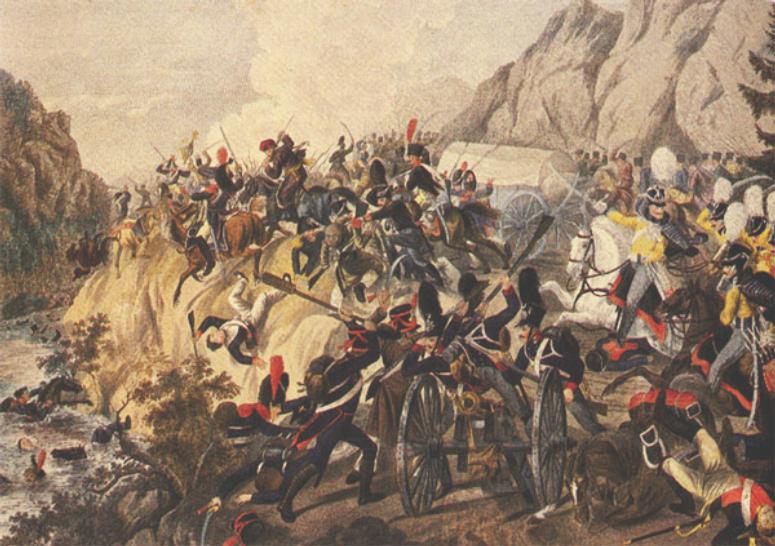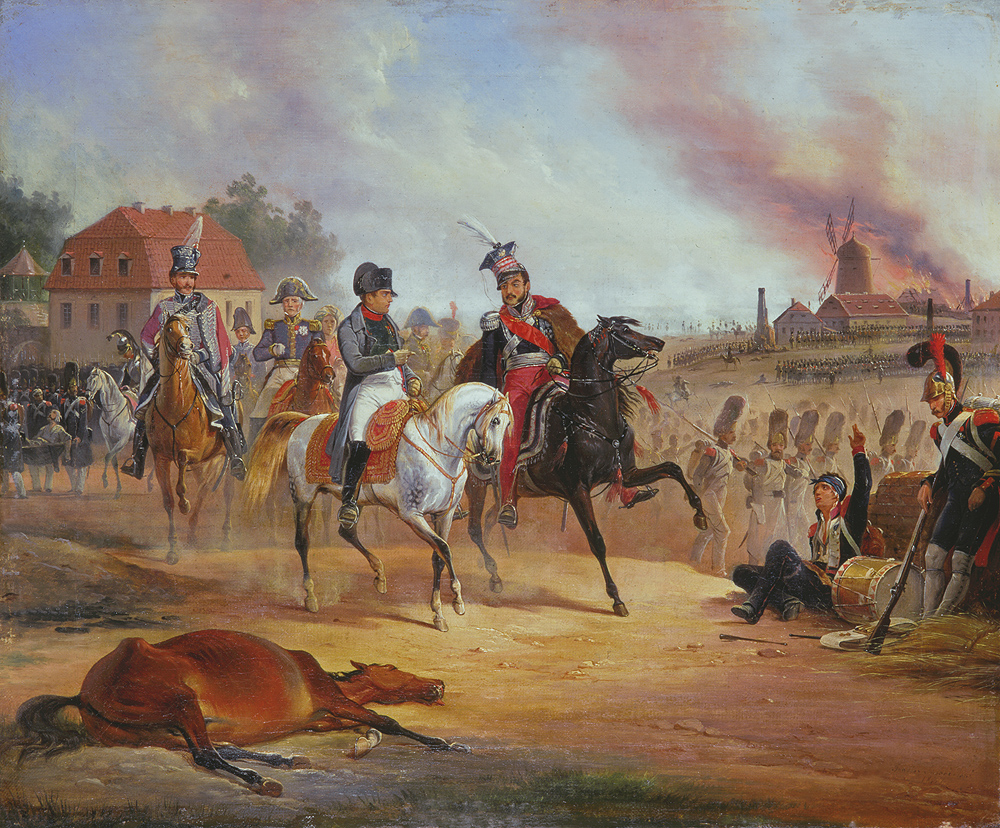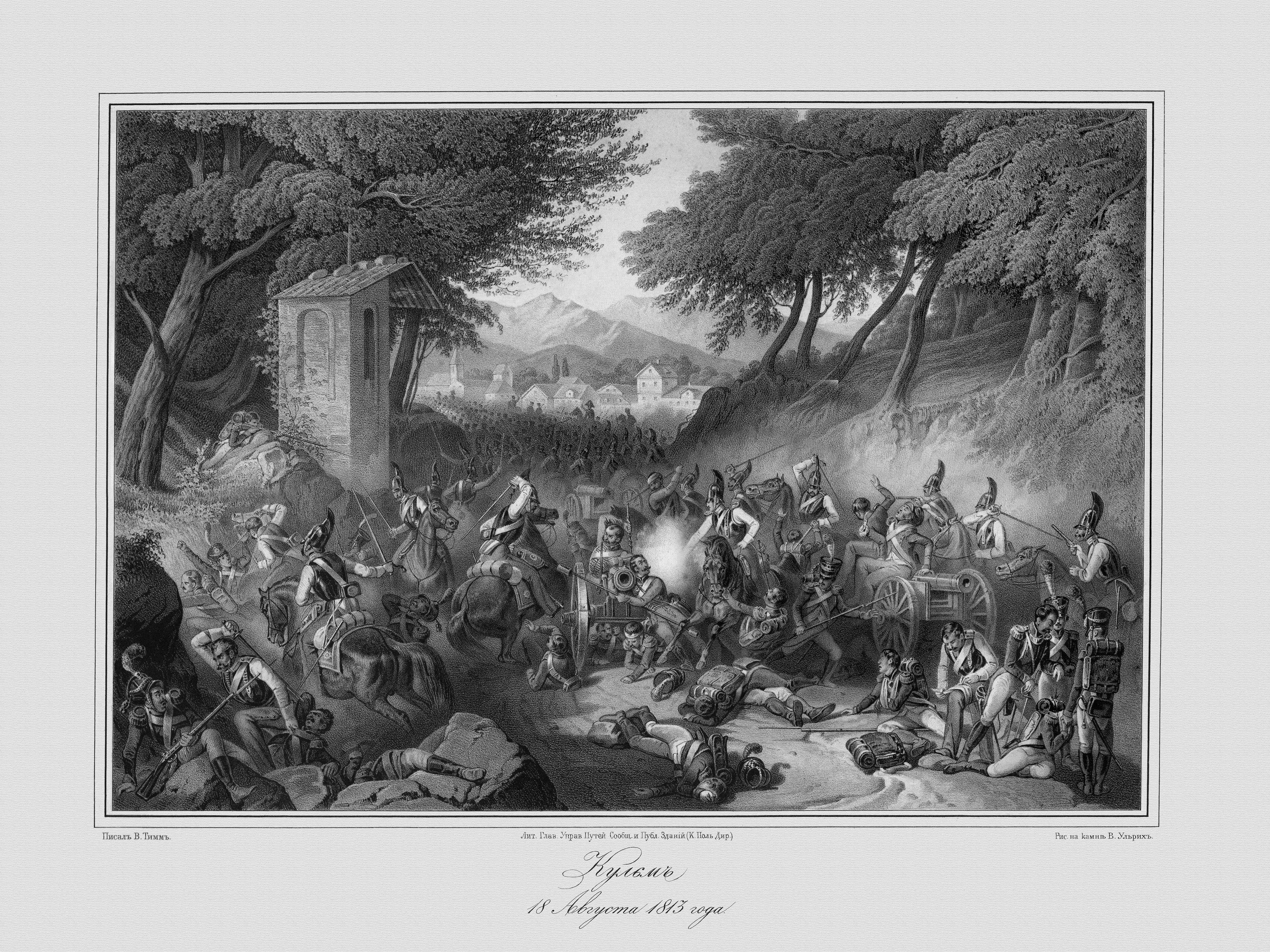|
Battle Of Katzbach
The Battle of the Katzbach on 26 August 1813, was a major battle of the Napoleonic Wars between the forces of the First French Empire under Marshal MacDonald and a Russo- Prussian army of the Sixth Coalition under Prussian Marshal Graf (Count) von Blücher. It occurred during a heavy thunderstorm at the Katzbach river between Wahlstatt and Liegnitz in the Prussian province of Silesia. Taking place the same day as the Battle of Dresden, it resulted in a Coalition victory, with the French retreating to Saxony. Prelude Blücher ordered the Army of Silesia to advance on 13 August, before the Truce of Pläswitz could conclude on 17 August. In a series of running fights, the Allied army beat back the confused French, who did not anticipate that the Allies would break the armistice so brazenly. These minor victories raised the morale of the inexperienced German levies. On the first day, Blücher and his chief of staff August Neidhardt von Gneisenau became separated and did not ... [...More Info...] [...Related Items...] OR: [Wikipedia] [Google] [Baidu] |
Eduard Kaempffer
Eduard Kaempffer (13 May 1859 in Münster – 22 March 1926 in Obernigk) was a German painter, sculptor and medallist. Life and work From 1875 to 1880, he studied with Eduard von Gebhardt and Peter Janssen at the Kunstakademie Düsseldorf. Then, from 1880 to 1881, he was enrolled at the Academy of Fine Arts, Munich, where he studied advanced techniques with Ludwig von Löfftz and . In 1885, he returned to Düsseldorf and lived in one of the homes owned by the widow of , a noted landscape painter who had recently died. That same year, he spent some time in Rome; supported by a stipend from the Abraham Wetter Foundation. Two years later, he was awarded a scholarship from the same foundation for his altarpiece, " The Flagellation of Christ", designed for the in Bad Neuenahr, on behalf of the . In 1891, he was back in Munich. In 1893, 1894 und 1895 he was awarded small gold medals at the Große Berliner Kunstausstellung. Following his award in 1895, he was appointed to the ... [...More Info...] [...Related Items...] OR: [Wikipedia] [Google] [Baidu] |
Battle Of Haynau
The Battle of Haynau was fought on 26 May 1813, between Prussian cavalry under the command of General Gebhard Leberecht von Blücher and a French infantry division under the command of General Nicolas Joseph Maison Nicolas Joseph Maison, marquis de Maison (; 19 December 1771 – 13 February 1840) was a French military officer who served in the French Revolutionary Wars, the Napoleonic Wars, and as commander of the Morea expedition during the Greek War of In .... The battle resulted in a Prussian victory. Prelude After their defeat at the Battle of Bautzen (20–21 May), the allies broke off the action at their own time and retired in such good order that Napoleon failed to capture a single trophy as proof of his victory. The enemy's escape annoyed him greatly, the absence of captured guns and prisoners reminded him too much of his Russian experiences, and he redoubled his demands on his corps commanders for greater vigour in the pursuit. Battle Napoleon's entreaties led ... [...More Info...] [...Related Items...] OR: [Wikipedia] [Google] [Baidu] |
Siege Of Hamburg
The siege of Hamburg was a military engagement of the War of the Sixth Coalition fought between French and Sixth Coalition forces in Hamburg. After being freed from Napoleonic rule by advancing Cossacks and other following Coalition troops it was once more occupied by Marshal Davout's French XIII Corps on 28 May 1813, at the height of the German Campaign of the war. Ordered to hold the city at all costs, Davout launched a characteristically energetic campaign against a similar numbered Army of the North made up of Prussian and other Coalition troops under the command of Count von Wallmoden-Gimborn, winning a number of minor engagements. Neither force was decidedly superior and the war ground to a halt and resulted in a rather stable front line between Lübeck and Lauenburg and further south along the Elbe river, even after the end of the cease-fire of the summer 1813. In October 1813 a French column's movement towards Dannenberg resulted in the only major engagement i ... [...More Info...] [...Related Items...] OR: [Wikipedia] [Google] [Baidu] |
Battle Of Sehested
The Battle of Sehested was fought on 10 December 1813 during the Dano-Swedish War of 1813–1814 between a Danish army under Prince Frederik of Hesse and a Coalition force led by Ludwig von Wallmoden-Gimborn. Near Sehested, Holstein, Frederik's troops defeated the Coalition army, inflicting over 1,100 casualties on von Wallmoden-Gimborn's force while suffering only 500. However, this victory did not prevent the Coalition from emerging victorious in the conflict in 1814. Background Denmark-Norway found itself involved in the Napoleonic Wars following the Battle of Copenhagen in 1807. To prevent the Dano-Norwegian navy from falling into French hands, British forces attacked and briefly occupied Copenhagen, capturing most of the Dano-Norwegian fleet at anchor. Denmark-Norway, which up till then maintained its neutrality in the conflict, thereafter sided openly with France. While keeping faith with this alliance, Frederick VI of Denmark tried to keep the country out of mi ... [...More Info...] [...Related Items...] OR: [Wikipedia] [Google] [Baidu] |
Battle Of Hanau
The Battle of Hanau was fought from 30 to 31 October 1813 between Karl Philipp von Wrede's Austro-Bavarian corps and Napoleon's retreating French during the War of the Sixth Coalition. Following Napoleon's defeat at the Battle of Leipzig earlier in October, Napoleon began to retreat from Germany into France and relative safety. Wrede attempted to block Napoleon’s line of retreat at Hanau on 30 October. Napoleon arrived at Hanau with reinforcements and defeated Wrede’s forces. On 31 October Hanau was in French control, opening Napoleon’s line of retreat. The Battle of Hanau was an important tactical victory allowing Napoleon’s depleted army to retreat onto French soil to prepare to face an invasion of France. Background The Battle of Leipzig, the largest and bloodiest encounter of the Napoleonic Wars, began on 16 October 1813, raged for three days and ended with a decisive victory for the Sixth Coalition. Napoleon was forced to abandon central Germany to the coa ... [...More Info...] [...Related Items...] OR: [Wikipedia] [Google] [Baidu] |
Battle Of Leipzig
The Battle of Leipzig, also known as the Battle of the Nations, was fought from 16 to 19 October 1813 at Leipzig, Saxony. The Coalition armies of Austria, Prussia, Sweden, and Russia, led by Tsar Alexander I, Karl von Schwarzenberg, and Gebhard von Blücher decisively defeated the ''Grande Armée'' of French Emperor Napoleon Bonaparte. Napoleon's army also contained Polish and Italian troops, as well as Germans from the Confederation of the Rhine (mainly Saxony and Württemberg). The battle was the culmination of the German campaign of 1813 and involved about 560,000 soldiers, 2,200 artillery pieces, the expenditure of 400,000 rounds of artillery ammunition, and 133,000 casualties, making it the largest battle of the Napoleonic Wars, and the largest battle in Europe prior to World War I. Decisively defeated, Napoleon was compelled to return to France while the Sixth Coalition kept up its momentum, dissolving the Confederation of the Rhine and invading France early the ... [...More Info...] [...Related Items...] OR: [Wikipedia] [Google] [Baidu] |
Battle Of Wartenburg
The Battle of Wartenburg () took place on 3October 1813 between the French IV Corps (Grande Armée), IV Corps commanded by General Henri Gatien Bertrand and the Allied Army of Silesia, principally the I Corps of General Ludwig Yorck von Wartenburg, Ludwig von Yorck. The battle allowed the Army of Silesia to cross the Elbe, ultimately leading to the Battle of Leipzig. Prelude Following his defeat at the battle of Dennewitz, Marshal Ney withdrew his army to defensive positions along the Elbe. The allied Army of the North, under the command of Charles XIV John of Sweden, Crown Prince Charles John of Sweden (formerly French Marshal Bernadotte), followed them cautiously but made no serious effort to cross the river. To the east, Gebhard Leberecht von Blücher, Marshal Blücher made a bold march skirting Napoleon's position in Dresden to join his Army of Silesia with the Army of the North, cross the Elbe, and threaten Napoleon's communications with France. Major von Rühle was ta ... [...More Info...] [...Related Items...] OR: [Wikipedia] [Google] [Baidu] |
Combat Of Roßlau
The Combat of Rosslau was fought in the War of the Sixth Coalition on 29 September 1813, near Rosslau, Germany. Michel Ney attacked the Swedish bridgehead at the Elbe, to stop the Army of the North from crossing the river. The Swedish commander Johan August Sandels counterattacked and chased the French for before being forced to retire himself. About 350 Swedes were dead and wounded while the French had 600 losses. The battle had no strategic effects, but it was one of very few times in the war that a Swedish force was fully committed in battle. Background A French force under Michel Ney had received orders from Napoleon I to attack the Swedish bridgehead over the Elbe river, at Rosslau, to stop the Army of the North (under the Swedish Crown Prince Charles John) from reaching Leipzig. After having fought a couple of skirmishes for control over Dessau, Ney marched his troops of about 7,000–8,000 men towards the Swedish left flank. The Swedes had around 4,000–4,500 men i ... [...More Info...] [...Related Items...] OR: [Wikipedia] [Google] [Baidu] |
Battle Of Altenburg
The raid at Altenburg on 28 September 1813 took place during the War of the Sixth Coalition's German Campaign of 1813. The raid was carried out by the ''Streifkorp'' under the command of Saxon General Johann von Thielmann commanding seven regiments of Cossacks, a squadron each of Saxon Hussars and Dragoons, and a detachment of '' Saxon Freikorps'' numbering about 1,500 cavalry. The objective of the raid was to attempt harassment of the French lines of communication 25 miles (45 km) south of Leipzig shortly before the Battle of Leipzig. The Austrian contingent was commanded by Emmanuel Mensdorff and the Russian contingent of Cossacks by Matvei Platov. Background The battle was the culmination of a raid in which Thielmann cavalry successfully attacked Napoleon's lines of communications along the roads between Erfurt and Leipzig in the Saale valley. Battle Thielmann completely surprised and routed a larger force of French cavalry, including Cavalry of the Imperi ... [...More Info...] [...Related Items...] OR: [Wikipedia] [Google] [Baidu] |
Battle Of The Göhrde
The Battle of the Göhrde took place during the War of the Sixth Coalition on 16 September 1813 between French and Coalition troops at Göhrde, Germany. The French troops were defeated and withdrew to Hamburg. Site The battle occurred near what is now the Göhrde State Forest (''Staatsforst Göhrde''), near Dannenberg, near Lüneburg. At that time this area belonged to the electorate of Braunschweig-Lüneburg (Hanover), which had been occupied by the French since 1803. Prelude In March 1813, Russian troops under Friedrich Karl von Tettenborn forced the French out of Hamburg and some northern areas of Hanover. In the wake of Prussia's reentry into the war against France, the eastern areas of Hanover also rose against Napoleon. Wallmoden then received overall command of all the Allied troops on the Lower Elbe: troops from Prussia, Russia, the United Kingdom, Hanover, Hamburg, Mecklenburg and Sweden, including the Russian German legion, the Lützow Free Corps, the Hans ... [...More Info...] [...Related Items...] OR: [Wikipedia] [Google] [Baidu] |
Battle Of Dennewitz
The Battle of Dennewitz () took place on 6September 1813 between French forces commanded by Marshal Michel Ney and the Sixth Coalition's Allied Army of the North commanded by Charles XIV John of Sweden, Crown Prince Charles John of Sweden, Friedrich Wilhelm Freiherr von Bülow, Friedrich Wilhelm von Bülow and Bogislav Friedrich Emanuel von Tauentzien, Bogislav von Tauentzien. It occurred in Dennewitz, a village in the Prussian province of Brandenburg, near Jüterbog, southwest of Berlin. The battle marked a turning point in the German Campaign of 1813 as not only did the Allied victory end Napoleon's hopes of capturing Berlin and knocking Prussia out of the war, but the severity of the French defeat, inflicted by a primarily Prussian force, also led to the erosion of fidelity of German allies to the Napoleonic cause. The French losses, and consequent diplomatic reverses, that resulted from Dennewitz contributed greatly to Napoleon's defeat a month later at the Battle of Leipz ... [...More Info...] [...Related Items...] OR: [Wikipedia] [Google] [Baidu] |
Battle Of Kulm
The Battle of Kulm was fought near the town Kulm () and the village Přestanov in northern Bohemia. It was fought on 29–30 August 1813, during the War of the Sixth Coalition. A French corps under General Dominique Vandamme attacked Alexander Osterman-Tolstoy's Russian corps on 29 August. The next day, Friedrich von Kleist's Prussian corps hit Vandamme in the rear while Russian and Austrian reinforcements attacked the French front and left. Vandamme was defeated with the loss of between 13,000 and 25,000 men and 82 guns. Background Following the French victory at Dresden, Vandamme pursued the retreating allies. Napoleon sent Marshals Gouvion Saint Cyr and Auguste Marmont to support Vandamme's corps. With Vandamme in advance, Saint Cyr's and Marmont's corps brought up the rear. Vandamme caught up with Alexander Ivanovich Ostermann-Tolstoy's forces near the town of Kulm, eight kilometres northwest of Aussig (Ústí nad Labem, now in the Czech Republic). Battle On ... [...More Info...] [...Related Items...] OR: [Wikipedia] [Google] [Baidu] |



